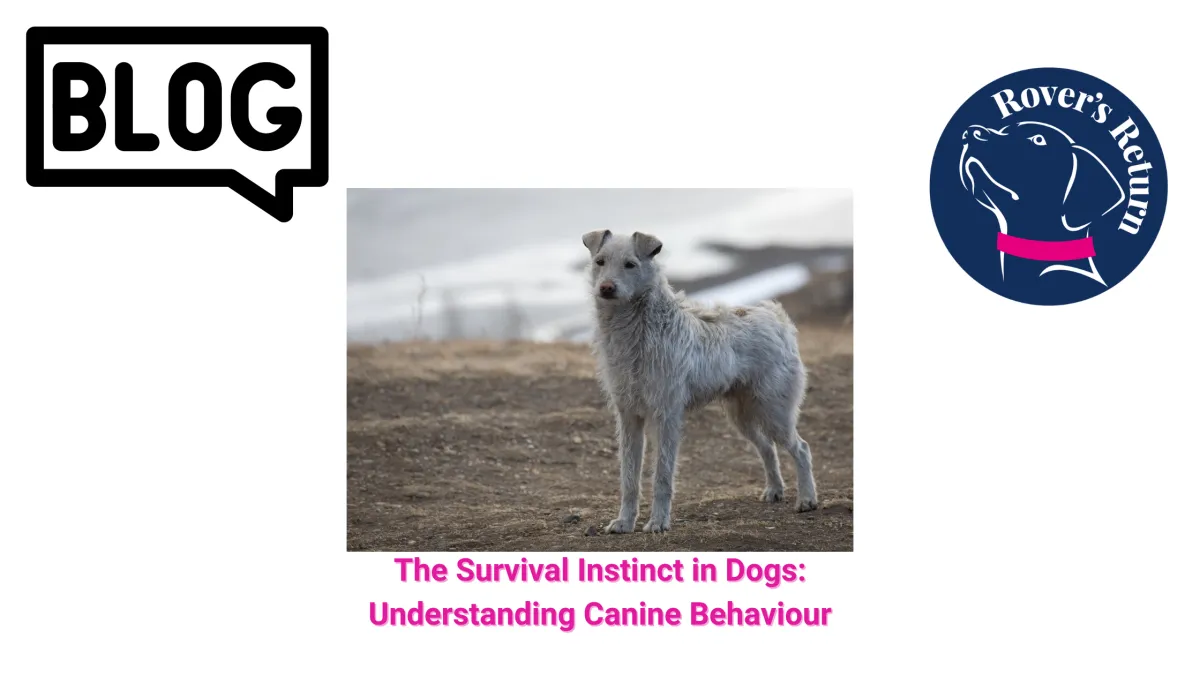Book a FREE 1:1 Assessment Call By Clicking HERE
Specialising In Dog Reactive Behviour
Accredited by APDT, ABTC and UK DOG Behaviour and Training Charter
Qualified and Experienced
Force Free Trainer and Behaviourist
Dog Training Leicestershire Educational Blogs

The Survival Instinct in Dogs: Understanding Canine Behaviour
“The survival instinct, a fundamental aspect of all living beings, is the innate drive to stay alive and protect oneself from harm..” - Sam Hughes

The Survival Instinct in Dogs: Understanding Canine Behaviour
Introduction:
What Are Instincts in Dogs?
Instincts are behaviours that dogs are born with. Dogs inherited their instincts from their ancestors the grey wolf, breed influence and the puppy's parents' life experiences and behaviours. The survival instinct has evolved over millions of years, ensuring that organisms capable of responding effectively to threats have a better chance of passing their genes to the next generation.
The survival instinct, a fundamental aspect of all living beings, is the innate drive to stay alive and protect oneself from harm. This powerful instinct influences behaviour in both overt and subtle ways, shaping responses to various situations and environments. Understanding the survival instinct's impact on behaviour provides valuable insights into actions and motivations, revealing the deep mechanisms governing your dog's life.

How do I understand my dog's behaviour?
The survival instinct is to seek out what increases the chances of survival and avoid what may harm them.
A common misconception about dogs is that they are pack animals. Dogs are social animals and can struggle when left alone. They do not see their family, or other animals in the household as their pack, they do not want to be the ‘top dog’. Dogs are mostly cooperative animals which increases social bonding, they want to live harmonious lives with other animals and humans. Dogs engage in cooperative behaviours and play, essential for social bonding and developing skills necessary for survival. Playful behaviours mimic hunting and fighting, providing both physical exercise and mental stimulation. Puppies learn how to be dogs playing with their siblings.
Perception of Threat Can Adversly Affect Your Dog's Behaviour.
Fear Affects Your Dog’s Behaviour
The inate need to avoid danger is essential for survival. Fear is triggered due to the event, a person or object. The situation that the dog is in will determine their behaviour. It may seem that the dogs response abnormal and inappropriate, but it isn't it is necessary for the dog to behave that way to cope with the situation. Every dogs response is unique to their emotions
If your dog percieves a situation as potentially dangerous a physiological stress response is triggered.
The reticular activating system triggers important events. It triggers responses to events that are
familiar,
unusual
problematic.
When these events happen the RAS signals the brain to react,
What Is The Fight Or Flight Principle In Dogs?
When faced with a threat, The emotional brain, the amygdala takes over and a reflex fight or flight response begins. Adrenaline surges, heart rate increases, and muscles tense. These physiological changes prepare the individual to confront danger and be able to cope with the threat and increase the chances of survival. Depending on the situation, the individual dog's temperament, and previous experiences their behaviour may be fighting, (reactive behaviour) flight, (stillness and freezing), flirting (may appear playful) or fainting.
All other functions shut down. The dog is not in a place where they have conscious thought, therefore punishment is not helpful and will only seek to add stress to the situation.
Cortisol flows through the bloodstream, lasting in the dog's system for several days, affecting behaviour.
Beyond the immediate fight-or-flight response, the survival instinct also shapes longer-term behaviours and strategies.
Pessimism - directly linked to the survival instinct dogs often avoid situations that pose significant risks to their safety. We may believe their behaviour is naughty or unnecessary, but these dogs are experiencing a real stress response. Their behaviour serves a purpose, heightening awareness of potential dangers and motivating actions to avoid threats. Pessimistic dogs will tend to overestimate the likelihood of threatening events, leading to heightened vigilance and precautionary behaviours.
Risk Perception: How dogs perceive and respond to risks is shaped by the survival instinct and the behaviours that have kept them safe previously will be repeated during similar events.
How Do I Understand What My Dog Is Saying?
Dogs communicate their discomfort through stress signals with their body language. Often these signals are subtle and are easily missed.
Low-level early communication signs may be seen through yawning, licking their lips, pinning their ears back tucking their tails and looking away from triggers.
Being attuned to these signals can help owners intervene before a dog needs to resort to more drastic survival behaviours.
When these low-level behaviours are ignored and the threat continues the brain triggers alternative responses relevant to the threat level. This can increase barking, growling and lunging.
Dogs rarely attack or bite with no warning. When they do it is because the level of threat is beyond their control and they are fighting to survive. Usually, they will have shown different signals that they are struggling to cope. As a dog owner, you must learn what your dog is communicating to you.

What Is An Unhappy Dog's Body Language?
When you are assessing how your dog feels, it is essential to look at their whole body. Their eyes, ears, fur, body stance, tail and looseness or tightness of the body.
The dog's tail wagging is not always a sign of happiness, if it is low, tight and wagging slowly it is a sign that your dog may be unhappy, however, you should also look at what the rest of the body is doing.
A good rule of thumb is a loose, calm, confident body with a tail mid to high is generally a happy dog.
A dog that has a stiff body, bristling fur, their tail low, tight and tucked, the ears may be back and the body stance low is likely a dog that is struggling in the situation, one or more of these signals may be present, but if they are all there then your dog should be removed from the situation.
Impact on Training and Behavior Management
Understanding your dog's survival instincts is vital for effective management and reducing their behaviour through training.
Positive Reinforcement: Training methods that use positive reinforcement align with a dog's natural survival instincts. Rewarding desired behaviours with treats, praise, or play taps into their motivation to seek resources and approval.
Socialisation: Early and ongoing effective socialisation helps dogs understand how to interact safely and appropriately with other animals and humans. This reduces fear-based reactions and promotes confident, well-adjusted behaviour
Safe Environment: Providing a safe and secure environment helps mitigate the impact of survival instincts. Ensuring dogs have a designated safe space, like a crate or a quiet room, can help them feel secure and reduce anxiety.
Consistent Routines: Dogs thrive on routine, which helps them predict and understand their environment. Consistent feeding, walking, and training schedules help reduce stress and enhance their sense of security.
Mental and Physical Stimulation: Engaging dogs in activities that stimulate their minds and bodies, such as puzzle toys, agility training, and regular exercise, helps fulfil their instinctual needs and prevent boredom-related behaviours.
Conclusion
The survival instinct is a powerful force that significantly shapes canine behaviour. By understanding these instincts, dog owners and trainers can better interpret and address their dogs' actions, building a harmonious relationship and enhancing the well-being of their canine companions. Recognising that many behaviours are rooted in the fundamental drive to survive allows for more compassionate and effective approaches to care and training.
Rovers Return Dog Training and Behaviour offers programs to help you understand your dog's behaviour and give you a successful training plan to reduce reactive behaviours and improve optimsim.
Highly Qualified Behaviourist
Accredited by APDT, ABTC and UK DOG Behaviour and Training Charter
Accredited Scentwork Instructor
Force Free Trainer and Behaviour
Force Free Trainer and Behaviour
Accredited Scentwork Instructor
Accredited by APDT, ABTC and UK DOG Behaviour and Training Charter
Highly Qualified Behaviourist
Contact Us
Sam: 07725 802995
You can contact us via Live Chat button at the bottom of the screen or the contact box to the right.
You can also book one of our services online using the View Dates buttons under the service you require.
© 2023 by Rovers Return Dog Trainers Academy - Force Free Dog Training Lutterworth, Broughton Astley, Leicestershire, Hinckley, Nuneaton, Stoney Stanton, South Kilworth, Ullesthorpe
Privacy Policy | Terms and Conditions | Terms and Conditions of Services | Sitemap


Facebook
Instagram
X
LinkedIn
Youtube
TikTok